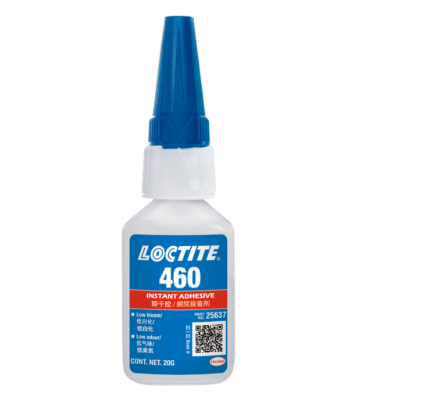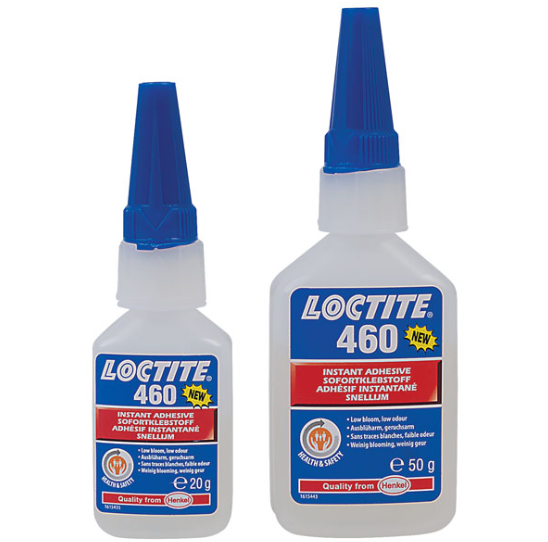Loctite 460 Review: The Unsung Hero of Instant Adhesives (That Quietly Saves Your Day)
Loctite 460


Loctite 460

If you’ve ever tried gluing something that refused to stay glued — like plastic that sneers at your hardware store glue — you’ll understand the frustration. That’s where Loctite 460 quietly walks in like a superhero who doesn’t wear a cape… just a 20g bottle.
It’s not flashy. It doesn’t boast like other “super glues.” But once you use it, you’ll realize why so many engineers, maintenance pros, and even DIY hobbyists swear by it. I’ve personally used it in multiple real-world applications — from fixing industrial machine components to repairing a leather belt (yes, that happened) — and the results were jaw-dropping.
So, let’s dive deep into what makes Loctite 460 adhesive the silent champion in a world full of loud promises.
What Exactly Is Loctite 460?
According to the Loctite 460 datasheet, this little powerhouse is a low-odor, low-bloom cyanoacrylate adhesive — or, in normal human language, a super glue that doesn’t sting your nose or leave that ugly white residue when it dries.
It’s built on alkoxyethyl cyanoacrylate technology, meaning it cures super-fast when it meets a bit of humidity (yep, even the moisture in the air). No mixing. No waiting hours. Just instant bonding.
Best for:
- Metals
- Plastics
- Elastomers (rubbers)
- Wood, paper, leather, fabric
And if you’ve ever tried gluing something porous (like foam or cloth) and ended up with a mess — this glue will change your life.
Why Engineers Secretly Love It
Most people think all super glues are the same. Not even close.
Loctite 460 is like the strong, silent guy in the corner who doesn’t talk much but does his job perfectly. It has low viscosity (25–55 mPa·s), which means it spreads evenly and gets into tight spots without dripping like crazy.
Even better — it’s low odor, unlike Loctite 401 or other instant adhesives that can make your nose curl up like burnt plastic.
Here’s what sets it apart:
- ✅ No white bloom (so your repairs look clean and professional)
- ✅ Low fume emission (perfect for confined spaces)
- ✅ Fast cure time (sets in 5–30 seconds depending on material)
- ✅ Strong bond on difficult materials (like rubber and PVC)
If you compare Loctite 401 vs 460, the biggest difference is smell and bloom. 460 wins hands down for delicate assembly and aesthetic work.
And if you pit Loctite 406 vs 460, 406 is more aggressive on plastics, while 460 gives you finesse — ideal when appearance and precision matter.
The Factory Machine That Wouldn’t Stop Leaking
Let me tell you a story from an industrial plant in Nairobi.
One of our packaging machines had a small rubber gasket that kept slipping out of position. We’d tried everything — standard super glue, silicone, even a temporary fix with tape (yes, we were desperate).
Then came Loctite 460.
We cleaned the surfaces with Loctite cleaner, applied a tiny drop on the gasket, and waited 15 seconds. Boom. Instant grip. The machine went back into operation immediately — no curing oven, no downtime.
Result?
That same gasket is still in place 18 months later. No leakage. No rework.
What impressed the maintenance crew most was that the glue didn’t fume up or leave a white residue on the metal frame — unlike older glues that made the part look like it had dandruff.
The Leather Bag That Refused to Retire
Now, a totally different world: my wife’s favorite leather handbag. It had a tear at the handle seam, and she wanted to throw it away.
“Don’t worry,” I said with misplaced confidence, “I’ll fix it.”
Five glues later, the bag was still laughing at me — until I remembered Loctite 460 from work.
A thin line of the clear liquid on the inside of the seam, a firm press for 30 seconds, and done. No stains, no smell, no evidence of repair.
Three months later, the bag is still hanging proudly, carrying everything from perfume to power banks. She still doesn’t believe it’s glued — and I don’t plan to tell her how easy it was.
Loctite 460 Technical Strength — in Plain English
Here’s what the Loctite 460 TDS (Technical Data Sheet) says, translated into human terms:
| Property | Value |
|---|---|
| Viscosity | 25–55 cP (flows like thin syrup) |
| Fixture time | 5–30 seconds depending on surface |
| Full cure time | 24 hours (for maximum resistance) |
| Tensile strength | Up to 30 N/mm² (≈ 4,330 psi!) |
| Temperature range | -40°C to +120°C |
| Appearance | Clear, colorless to straw-colored |
| Cure method | Humidity (no activator needed for most jobs) |
That’s serious bonding power for a bottle that fits in your shirt pocket.
How to Use Loctite 460 Like a Pro
If you want that “factory-level” bond instead of a weekend DIY disaster, follow these steps:
- Clean your surfaces – Grease, oil, or dust will ruin everything. Use Loctite cleaner or isopropyl alcohol.
- Dry completely. A little moisture is good for curing, but you don’t want standing water.
- Apply a small drop – A little goes a long way. This is not peanut butter.
- Press the parts together – Hold firm for 10–30 seconds.
- Let it rest for 24 hours before exposing to heavy stress or chemicals.
If you’re working with low-energy plastics (like polyethylene or polypropylene), you can use a Loctite primer first to boost adhesion.
Performance You Can Trust (Even Under Stress)
The Loctite 460 SDS reveals it’s safe for metals and plastics when used properly — and doesn’t release harmful fumes like some low-grade alternatives.
But the real magic is in its environmental resistance.
Even after 1,000 hours in water, gasoline, or ethanol, it keeps 70–90% of its original bond strength. That’s insane endurance.
Engineers love it because it works in both extremes: from -40°C cold storage to +120°C hot machinery. That means it’s perfect for:
- Electronics assembly
- Rubber seals
- Automotive plastics
- Household fixes
- Leather & shoe repair
Basically, if it needs to stick and look clean — Loctite 460 is your guy.
Loctite 460 Price and Packaging
You’ll usually find Loctite 460 glue in 20g and 50g bottles.
It’s not the cheapest, but let’s be honest — one bottle lasts ages.
Typical market price (as of this writing):
- Loctite 460 20g → around KSh 2,500–3,000 (≈ USD 18–22)
- Loctite 460 50g → around KSh 6,000–7,000 (≈ USD 40–45)
That may sound pricey, but when a 5mm drop can hold 5 tons of metal together… it’s actually a bargain.
Loctite 460 vs the Competition
| Feature | Loctite 401 | Loctite 406 | Loctite 460 |
|---|---|---|---|
| Odor | Moderate | Moderate | Low ✅ |
| Blooming (white marks) | Medium | Medium | Very low ✅ |
| Plastic bonding | Good | Excellent ✅ | Excellent ✅ |
| Metal bonding | Excellent | Good | Excellent ✅ |
| Appearance-sensitive jobs | Average | Average | Best ✅ |
So if you’re assembling electronic housings, cosmetic parts, or decorative plastics — 460 wins every time.
A Few Funny Truths About Using Loctite 460
- You’ll start fixing everything in sight. (The “let’s glue this too” syndrome is real.)
- You’ll realize how weak every other “super glue” was.
- You’ll probably end up lending it to everyone in the workshop — and never get it back.
I’ve literally seen a coworker glue his glove to a part while rushing. Luckily, it released after soaking in warm water — but he still earned the nickname “Sticky Steve.” Ha!ha!ha!ha!
Final Verdict: Is Loctite 460 Worth It?
If you’re tired of unreliable glues that promise “instant” results but deliver “insta-failure,” Loctite 460 is your upgrade.
It’s:
- Cleaner
- Faster
- Stronger
- And safer to use indoors
Whether you’re an engineer, craftsman, or casual fixer, this adhesive will make you feel like a pro.
And if you care about aesthetics (no fogging, no smell, no mess), this is your soulmate in a bottle.
Pro Tip: Store It Right
Keep it in a cool, dry place (5°C–8°C if possible). It’s like keeping milk — too warm and it spoils, too cold and it thickens. Treat it well, and it’ll serve you for months.
Final Thoughts (and a Laugh)
Loctite 460 doesn’t shout for attention. It just sticks around (literally).
It’s that dependable friend you didn’t realize you needed — until everything else lets you down.
So, next time you’re choosing between glues, ask yourself:
“Do I want a fling that fails… or a bond that lasts?” 😄
What customers think of us




★★★★★
4.4 from 1,400+ customers
“Highly versatile”
“I used Loctite 460 on a rubber gasket that nothing else would hold. Three years later, still perfect.”
★ ★ ★ ★ ★
Joseph, Maintenance Engineer
“Authentic Leather industry”
“It saved me from replacing an expensive leather shoe. Looks brand new.”
★ ★ ★ ★ ★
Grace, Tailor
“Outstanding in Electrical Field”
“Finally, a glue that doesn’t fog up my clear plastic displays.”
★ ★ ★ ★ ★
Amina, Electronics Assembler
“Very Good”
“I use it daily in the factory for bonding nitrile seals — it’s just reliable.”
★ ★ ★ ★ ★
David, Plant Technician

citadol chemicals
You Need More Details and Quote
CALL US TODAY